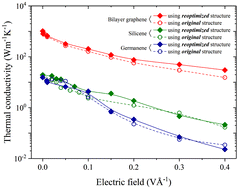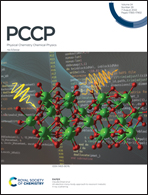Electrically-driven robust tuning of lattice thermal conductivity†
Abstract
The two-dimensional (2D) materials, represented by graphene, stand out in the electrical industry applications of the future and have been widely studied. As commonly existing in electronic devices, the electric field has been extensively utilized to modulate the performance. However, how the electric field regulates thermal transport is rarely studied. Herein, we investigate the modulation of thermal transport properties by applying an external electric field ranging from 0 to 0.4 V Å−1, with bilayer graphene, monolayer silicene, and germanene as study cases. The monotonically decreasing trend of thermal conductivity in all three materials is revealed. A significant effect on the scattering rate is found to be responsible for the decreased thermal conductivity driven by the electric field. Further evidence shows that the reconstruction of internal electric field and generation of induced charges lead to increased scattering rate from strong phonon anharmonicity. Thus, the ultralow thermal conductivity emerges with the application of external electric fields. Applying an external electric field to regulate thermal conductivity illustrates a constructive idea for highly efficient thermal management.

- This article is part of the themed collection: 2022 PCCP HOT Articles


 Please wait while we load your content...
Please wait while we load your content...